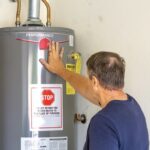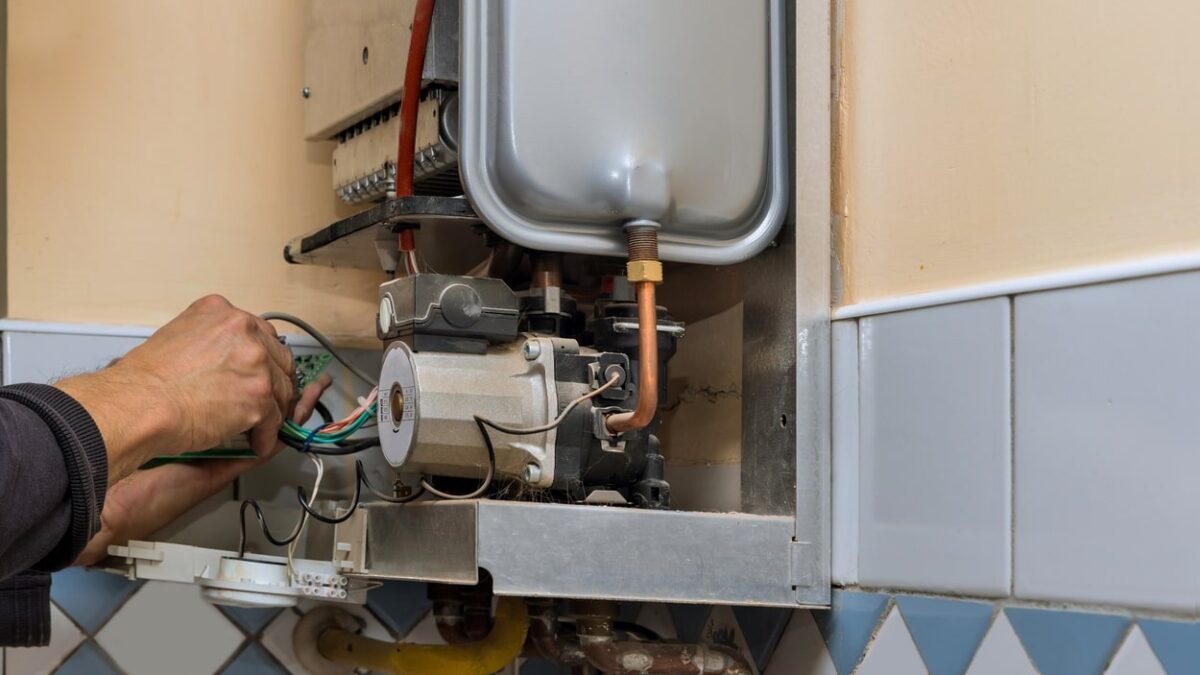
The Basics of Water Heaters: Why Your Hot Water Heater May Not Be Draining
October 20, 2023
Navigating Plumbing Issues: Why Your Faucet May Not Turn Off and How to Address It.
November 29, 2023Are you constantly worried about running out of hot water when taking a shower? Well, you’re not alone. It’s a common concern for many homeowners, and it’s important to know how long you can shower with a 40-gallon water heater. In this article, we will explore the average shower time and tips to maximize your water heater’s capacity. So, let’s dive in!
What Is a Water Heater and How Does It Work?
A water heater is a vital device that heats water for a variety of purposes, including showers, cleaning, and cooking. It functions by utilizing an energy source, such as gas or electricity, to heat and store water in a tank. When a hot water faucet is opened, the water travels from the tank through a pipe and is delivered to the desired location. The heated water is then replaced with cold water, which is heated to maintain the desired temperature. Water heaters are crucial for supplying hot water in both homes and buildings.
Types of Water Heaters
When it comes to choosing a water heater, there are various options available on the market. Each type offers its own set of benefits and drawbacks, making it crucial for homeowners to understand the differences between them. In this section, we will discuss the four main types of water heaters: conventional storage tanks, tankless, heat pumps, and solar. By learning about these different options, you can make an informed decision on which type of water heater best suits your needs.
1. Conventional Storage Tank Water Heaters
Conventional storage tank water heaters are the most common type of water heater used in residential settings. They function by storing and heating a large amount of water in a tank, making it readily available for use whenever needed.
Here are some steps to keep in mind when using a conventional storage-tank water heater:
- Set the temperature: Adjust the thermostat to your desired temperature, typically around 120 degrees Fahrenheit.
- Monitor usage: Be mindful of your water usage to avoid running out of hot water.
- Insulate the tank: Insulating the tank can help reduce heat loss and improve energy efficiency.
- Maintain the tank: Regularly drain and flush the tank to remove any sediment buildup.
- Consider a timer: Installing a timer can help control the water heater’s operation, especially during off-peak hours.
To maximize the efficiency of your conventional storage-tank water heater, be sure to also insulate your hot water pipes and consider upgrading to a more energy-efficient model when needed.
2. Tankless Water Heaters
Tankless water heaters offer several advantages over conventional storage tank water heaters.
- Energy efficiency: Tankless water heaters only heat water as needed, resulting in lower energy consumption and cost savings.
- Endless hot water: Unlike storage tank water heaters, which can run out of hot water, tankless units provide a continuous supply.
- Space-saving design: Tankless water heaters are compact and can be installed in tight spaces, such as closets or utility rooms.
- Longer lifespan: Tankless units typically have a longer lifespan compared to storage tank water heaters.
Tankless water heaters, also known as on-demand water heaters, have been used in Europe and Asia for decades, where space constraints and energy efficiency are prioritized. The technology has gained popularity in recent years in North America, especially in the form of 2. Tankless Water Heaters, due to its numerous benefits.
3. Heat Pump Water Heaters
Heat pump water heaters provide an efficient alternative to traditional water heaters. Follow these steps to select and maintain a heat pump water heater:
- Research: Gain an understanding of how heat pump water heaters operate and the advantages they offer compared to other types of water heaters.
- Sizing: Determine the appropriate size based on the hot water needs of your household.
- Installation: It is recommended to hire a professional for proper installation to ensure optimal performance.
- Maintenance: Keep the air filter clean, check for leaks, and schedule professional maintenance regularly.
- Temperature Settings: Adjust the temperature settings to balance energy efficiency and comfort.
- Insulation: Prevent heat loss by insulating the area surrounding the water heater.
- Efficiency: Take advantage of features such as vacation mode and timer settings to reduce energy consumption.
4. Solar Water Heaters
Solar water heaters are a cost-effective and environmentally friendly option for heating water. If you are considering using solar water heaters, here are some steps to keep in mind:
- Make sure that the solar panels are properly installed on your roof or in an open area with ample sunlight exposure.
- Connect the solar panels to the water storage tank to allow the sun’s rays to heat the water.
- Have a backup heating system in place for days with cloudy weather or high water demand.
- Regularly check and maintain the solar panels and storage tank to ensure optimal performance.
To increase the efficiency of your solar water heater, consider implementing these suggestions:
- Insulate the storage tank and pipes to minimize heat loss.
- Use water-efficient fixtures and appliances to reduce water consumption.
- Take advantage of government incentives and tax credits for installing solar water heaters.
What Is a 40-gallon Water Heater?
A 40-gallon water heater is a specific type of water heater that is capable of storing 40 gallons of water. It is commonly utilized in residential settings to supply hot water for various tasks, including showering, bathing, and washing dishes. This type of water heater is typically powered by either electricity or gas and is specifically designed to heat and store a set amount of water at a time. The size of the water heater is crucial as it dictates the quantity of hot water that can be used before the tank needs to be refilled and reheated.
How Long Can You Shower with a 40-gallon Water Heater?
Taking a hot shower is a simple pleasure that many of us enjoy, but have you ever wondered how long you can shower with a 40-gallon water heater? In this section, we will discuss the various factors that can affect the length of your shower, including the flow rate of your showerhead, the temperature setting of your water heater, and your water usage habits. By understanding these factors, you can make the most out of your water heater and enjoy longer more satisfying showers.
Factors That Affect Shower Length
The length of a shower using a 40-gallon water heater can vary based on a few different factors:
- Flow Rate of the Showerhead: Showers with higher flow rates will use up water more quickly.
- Temperature Setting of the Water Heater: Higher water temperatures will result in more hot water being consumed.
- Water Usage Habits: Some people may take longer showers or use more water for other purposes.
To make the most of your 40-gallon water heater, consider installing water-efficient fixtures, taking shorter showers, and using cold water for laundry and dishwashing. These practices can help save hot water and allow for longer shower times.
1. Flow Rate of the Showerhead
The flow rate of the showerhead is an important factor to keep in mind when using a water heater. Here are the steps to determine and adjust the flow rate:
- Measure the flow rate: Place a bucket under the showerhead and turn on the water. Time how long it takes to fill the bucket.
- Calculate the flow rate: Divide the volume of water in the bucket (in gallons) by the time taken (in minutes) to fill it. This will give you the flow rate in gallons per minute (GPM).
- Adjust the flow rate: If the flow rate is higher than desired, consider replacing the showerhead with a low-flow alternative or installing a flow restrictor.
2. Temperature Setting of the Water Heater
The temperature setting of a water heater is a crucial aspect to consider for optimal performance and safety.
- Locate the temperature dial on the water heater.
- Use a thermometer to measure the hot water’s temperature at a faucet.
- Adjust the water heater’s temperature setting by turning the dial.
- For safety purposes, it is recommended to keep the temperature setting at or below 120 degrees Fahrenheit to prevent scalding.
- Consider lowering the temperature setting to conserve energy and reduce the risk of burns.
- Refer to the manufacturer’s guidelines for recommended temperature settings based on your specific needs and usage.
3. Water Usage Habits
Efficient water usage habits can help optimize the performance of a 40-gallon water heater:
- Install water-efficient fixtures such as low-flow showerheads and faucets to decrease water consumption.
- Limit shower time by using a timer or setting a goal for the duration of your shower.
- Whenever possible, use cold water for laundry and dishwashing to decrease the amount of hot water used.
Tips for Maximizing Your 40-Gallon Water Heater
As homeowners, we rely on our water heaters for everyday tasks like showering, laundry, and dishwashing. But have you ever wondered how long you can shower with a 40-gallon water heater? In this section, we will discuss some practical tips for maximizing the use of your 40-gallon water heater, including installing water-efficient fixtures, taking shorter showers, and using cold water for laundry and dishwashing. By following these tips, you can make the most of your water heater and save on energy costs.
1. Install Water-Efficient Fixtures
Installing water-efficient fixtures is a great way to save water and make the most out of your 40-gallon water heater.
- Replace old showerheads with low-flow or aerated showerheads to decrease water consumption.
- Install faucet aerators on bathroom and kitchen faucets to limit water flow while maintaining water pressure.
- Consider using dual-flush toilets or toilet tank fill diverters to minimize the amount of water used for flushing.
- Upgrade to water-efficient appliances, such as dishwashers and washing machines, that have high Energy Star ratings.
- Regularly check for leaks and promptly repair any dripping faucets or pipes to prevent water waste.
2. Take Shorter Showers
Reducing your shower time can help conserve water and energy, saving you money and benefiting the environment. Here are some steps to take shorter showers:
- Set a timer or use a shower app to track your shower time.
- Turn off the water while lathering or shampooing your hair.
- Use a low-flow showerhead to reduce water usage without compromising water pressure.
- Avoid spending excessive time in the shower, and aim for efficient and quick rinsing.
- Consider taking a navy shower, where you turn off the water while lathering and only briefly turn it on for rinsing.
- Encourage your family members to also adopt shorter shower habits.
3. Use Cold Water for Laundry and Dishwashing
Using cold water for laundry and dishwashing offers several benefits:
- Energy savings: Heating water accounts for a significant portion of energy usage in households. By using cold water, you can decrease your energy consumption and lower your utility bills.
- Preserving clothing: Cold water is gentler on fabrics, helping to prevent fading, shrinking, and damage to delicate garments.
- Improved stain removal: Some stains, like blood or grass, respond better to cold water, preventing them from setting and making them easier to remove.
- Environmental impact: Hot water usage contributes to greenhouse gas emissions. By using cold water, you can reduce your carbon footprint and help protect the environment.
Fact: Washing laundry in cold water can save up to 90% of the energy used by a washing machine during each cycle.
Signs That Your Water Heater Needs to Be Replaced
As with any appliance, your water heater has a limited lifespan and will eventually need to be replaced. But how do you know when it’s time to say goodbye to your trusty water heater and invest in a new one? In this section, we will discuss the key signs that indicate your water heater is on its last legs. From the age of the water heater to strange noises coming from it, we’ll explore the tell-tale signals that it’s time for a replacement.
1. Age of the Water Heater
The age of a water heater is an important factor to consider when determining if it needs to be replaced. Here are a few steps to determine the age of your water heater:
- Locate the manufacturer’s label on the water heater.
- Find the serial number on the label.
- The first four digits of the serial number typically indicate the month and year of manufacture.
- Consult the manufacturer’s website or customer service for specific instructions on how to decode the serial number.
2. Rusty or Discolored Water
If you notice rusty or discolored water coming from your water heater, it may indicate a problem that needs attention. Here are some steps to address this issue:
- Check if the discoloration is occurring with hot water, cold water, or both.
- Flush your water heater by turning off the power supply and attaching a hose to the drain valve.
- Open the drain valve and allow the water to flow until it runs clear.
- If the problem persists, consider replacing the anode rod, which helps prevent rusting inside the tank.
- If the issue continues, contact a professional plumber to inspect and repair the water heater.
Remember, addressing rusty or discolored water promptly can help maintain the efficiency and longevity of your water heater.
3. Strange Noises Coming from the Water Heater
Strange noises coming from a water heater can be a sign of underlying issues that require attention. Here are some steps to troubleshoot and address the problem:
- 1. Identify the noise: Is it a popping, banging, or rumbling sound?
- 2. Check for mineral buildup: Sediment accumulation in the tank can cause unexpected noises. Drain and flush the tank to remove any sediment.
- 3. Inspect the heating elements: Loose or faulty heating elements can be the cause of strange noises. Tighten or replace them if necessary.
- 4. Examine the expansion tank: A faulty or waterlogged expansion tank can also contribute to unusual noises. Test and replace it if needed.
4. Frequent Repairs
Frequent repairs on a water heater can be frustrating and costly. To address this issue, here are some steps to consider:
- Regular maintenance: Schedule annual maintenance to identify and fix minor issues before they become major problems.
- Inspect the heating elements: Check for signs of wear or damage and replace them if necessary.
- Flush the tank: Regularly flushing the tank removes sediment buildup, improving efficiency and preventing damage.
- Check the pressure relief valve: Ensure it is functioning properly to prevent excessive pressure in the tank.
- Monitor for leaks: Address any leaks promptly to prevent further damage.
By following these steps, you can minimize the need for frequent repairs and extend the lifespan of your water heater.

